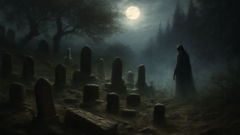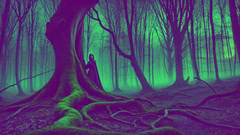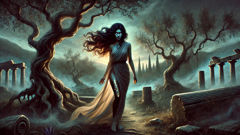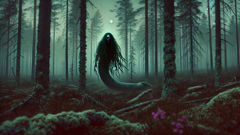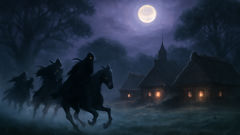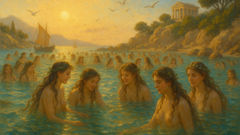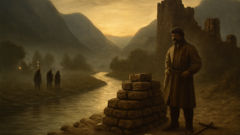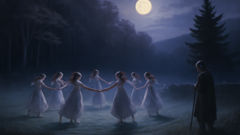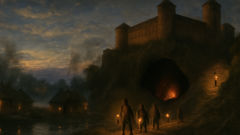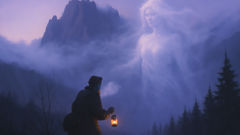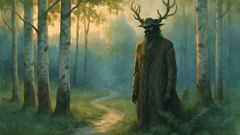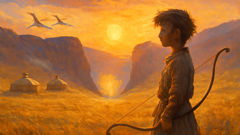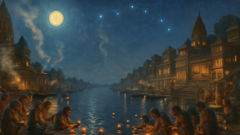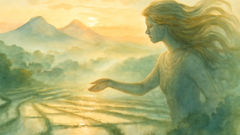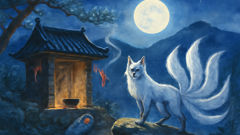Introduction
On nights when the air sits heavy and the moon hangs low over the limestone ridges of mainland Greece, villagers close their shutters, knot their blankets tighter, and speak in hushed voices of a thing older than fear: the vrykolakas. This creature, part corpse and part revenant, moves between the world of the living and the grave with a rancid patience. To speak of the vrykolakas is not merely to recount a ghost story. It is to trace how communities once guarded themselves against death’s uncanny aftertaste, how priests and midwives, grave-diggers and gossiping cooks preserved rites to keep souls where they belonged. The legend folds geography into theology, medicine into superstition, and ordinary human misunderstandings into monstrous possibility. Born in the margins where Christianity met ancient rural practices, the vrykolakas has worn many faces — a corpse that refuses to rot, a nocturnal predator that drinks from wells, a restless spirit capable of bringing plague and decay. In villages tucked between olive groves and pine-scented slopes, older generations remember that certain deaths were feared not because the person was cruel, but because the circumstances of their passing hinted the soul might not be at peace. Sudden deaths, violent ends, suicides, unshriven sinners, or bodies that returned from the sea sometimes became the seedbeds for vrykolakas tales. What followed were rituals, some tender, some harsh: stones placed upon stubborn graves, metals driven into chests, the burning of hair, and the recitation of prayers until dawn. This introduction begins the long walk through that uneasy landscape — a careful examination of origins, a catalog of signs and protections, and a chorus of village accounts that ask us to listen closely to the margins where the living and the dead meet. As we step inside these stories, keep in mind that folklore is both mirror and map: it reflects cultural anxieties and offers directions for surviving them. The vrykolakas is as much about how communities try to live after loss as it is about what they fear will come back for them.
Roots and Rites: Origins of the Vrykolakas
The vrykolakas does not belong to a single neat origin story. Instead, it emerges when different currents of belief cross: Hellenic notions of restless dead, Byzantine Christian rites, Ottoman-era survival strategies, and the universal human response to grief and unexplained death. To study the origins of the vrykolakas is to read centuries of local practice layered atop theological doctrine and seasonal desperation.
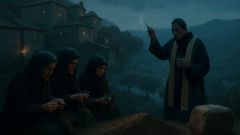
In the earliest recorded mentions, travelers and clerics used a variety of words that would later harden into the vrykolakas of rural speech. Byzantine texts, with their concern for proper burial and the redemption of souls, often suggested that improper deaths — those without confessions or final rites — could produce a lingering presence. In places where the Christian calendar folded over older, darker folkways, this anxiety found ritual expression. Pagan ideas about the potency of the throat, the mouth, and the heart remained stubborn. If a body was found with open eyes, if the corpse seemed uncorrupted, or if a person drowned or was killed suddenly, communities sometimes took extra measures to ensure the dead remained dead. These actions, pragmatic and symbolic, became the scaffolding for later descriptions of the vrykolakas.
Local descriptions vary. In some islands and coastal towns, the vrykolakas is an animated corpse that walks at dusk. In mountainous villages, it is a shadow that squeezes into houses through keyholes and causes livestock to sickened. Oral reports speak of a smell like wet earth and spices that trails the creature, and of breath that is colder than wind. Clergy who recorded alleged incidents often framed the phenomenon as demonic possession of the corpse, a way for malign forces to mock the sanctity of death. Folk healers, on the other hand, suggested earthly reasons: an untreated disease, a body not allowed to return to the soil, or the unsettled heart of someone who died an unjust or lonely death.
These practical concerns led to a suite of rituals that read as both reverent and ruthless. In places where fear ran high, villagers pinned coins on the eyes, sewed mouths shut, placed heavy stones atop coffin lids, or drove iron nails through chest cavities. Sometimes, they lit fires of rosemary to purify the air; other times, they burned the deceased’s hair and clothing to break attachments. Priests ritually read prayers and chased away suspected revenants with holy water. The most extreme measures — exhumation, decapitation, or immolation — were rare but have left their mark in archival records and in family stories; these acts, horrifying to modern sensibilities, often came from a place of communal terror and the imperative to protect the living.
Anthropologists who studied the vrykolakas in the 19th and 20th centuries found a face persistent across the region: the vrykolakas occupies a moral gray space in which beliefs about the proper life and the proper death intersect. The creature is not purely monstrous; it is an index of social rupture. When a community could not perform the rites that made death socially legible, the vrykolakas filled that silence with a narrative: a wandering of blame; a place to put sorrow, anger, and the guilt of failed rituals. In a landscape of terraced fields that depend on close communal labor, the fear of contamination from an unquiet corpse made practical sense: sickness and livestock disease could follow social neglect of bodies and burial places.
Finally, the vrykolakas became enshrined in literature and in the archival pens of priests and consuls, taking on new attributes with each telling. Travelogues transcribed a folklore that balanced sensationalism and ethnography. Local ballads immortalized particular tales: a widow who refused to turn over her dead husband to the church, a fisherman who was found bloody and uncorrupted after being lost at sea, a child who returned from a fever with eyes like a stranger’s. Each story embroidered the vrykolakas into the fabric of village life, not simply a monster to fear but a story to rehearse seasons of grief and the moral codes of communal survival. Over centuries, the creature shifted between labels — from revenant to vampire to restless spirit — but always remained anchored to the practices and anxieties that shaped rural Greek life.
Understanding these roots helps explain why the remedies against the vrykolakas often combined prayer and pragmatism. They were not only attempts to dispatch a supernatural predator; they were ways to repair social order, to reassert the rules that govern how people die and how they are remembered. In that sense, the myth of the vrykolakas is a cultural tool for maintaining cohesion, an ancient and sometimes brutal way of guaranteeing that the living need not fear the dead rising as an accusation or as a physical threat.
Signs, Protections, and the Nightly Haunting
Across Greece, the signs of a vrykolakas are as varied as the landscapes they haunt, but patterns emerge in oral testimony and written records. People spoke of nocturnal visits: a loved one rising to stand by the bedside, a figure slipping through shutters, an animal corpse found strangely whole in the morning. Others reported a procession of minor misfortunes that clustered around a household after a questionable death — milk that soured overnight, a well with cloudy water, dogs that howled at empty corners. The vrykolakas was often described less as a single monstrous body and more as a disruptive presence that turned the ordinary into the uncanny.
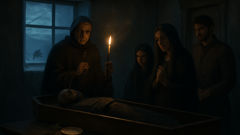
Some of the most persistent signs are physical. Relatives would report that the corpse refused to lie still, that its lips were red, or that its hair seemed to have fresh dew when the ground was dry. In coastal villages, bodies recovered from the sea that inexplicably lacked putrefaction were suspected; villagers feared the sea had not claimed them wholly, leaving behind a half-life that could cross thresholds. These signs made death into a visible danger and transformed grief into vigilance. Communities created simple observation practices: watch over the body for three nights, keep the house lit, and have someone sleep with a knife beneath their pillow. The watch itself was a ritual — eyes staying open even when the heart wanted to close.
Protection measures mixed the sacred and the practical. Christians invoked saints and the cross; a familiar safeguard was to place a coin or a sprig of basil in the coffin to pay or purify the way. The power of iron, long associated with warding off malign spirits in many cultures, was applied in nails and implements placed near graves. Garlic and olive oil, sources of both culture and material protection, showed up in the recipes of the fearful. Some families kept written petitions for saints tucked into wood coffins; others went further, calling priests to intervene with exorcistic rites. The logic was simple: the villager facing an uncertain death wanted to ensure the soul’s trajectory toward light, not back into the households that still needed tending.
The night visit — the central image in vrykolakas stories — is where folklore performs its most visceral work. Accounts vary widely, but often begin with a late-hour sound: a slow thud at the door, a whispering like wind through shutters, the clink of a coin against a threshold. That sound is not neutral; it is the story’s claim on attention. When villagers rise to check, they find the impossible: footprints that begin at the threshold and vanish into the house with no clear origin, or a bed that has been tamped down as if someone had just left it. Livestock are found drained and lethargic. Neighbors awake with the smell of damp earth in their rooms and a sense of being watched by a presence that moves like memory and hunger combined.
One common motif across many witness accounts is the exchange of identity. The vrykolakas sometimes appears in the outward form of a recently deceased neighbor, returning to sit, to touch, and to speak. Loved ones find themselves drawn to answer, to pull back a veil that they should not have. This is the danger: the revenant’s intimacy is its weapon. Folklore instructs that one should not be fooled by resemblance. A mother in a Cretan tale kissed her dead son before a priest could intervene; the kiss burned her tongue, a sign that imitation failed to equal the living reality. In that story, the vrykolakas uses resemblance to erode communal defenses. The remedy in these accounts is always procedural: delay physical contact, summon witnesses, and rely on ritual mediation.
Communities also developed preventive architecture. Graves were oriented, fenced, and sometimes weighted. The truly feared cases were those in which a grave was too shallow, or where the dead had been buried in haste. In winter months, when frost kept the earth from closing, people fretted that the cold would keep graves from sealing properly. To compensate, they might place a slab across the chest or lay a coin over the lips. In some villages, the custom was to place a stone inside the coffin to keep the corpse heavy and unwilling to rise. Other practices had a poetic logic: laying basil on the coffin — a plant associated with both culinary life and ritual purification — suggested that domestic life could anchor the soul.
Yet despite all the measures, the vrykolakas remained a feature of the night. The presence it embodied spoke to the unpredictability of death and the thinness of practical protections in the face of an inexplicable world. As communities debated protective measures, folklore responded with adaptable scripts. Sometimes priests formalized rites, other times midwives quietly preserved local customs. The enduring lesson of vrykolakas tales is not that magic is more efficacious than medicine or faith, but that societies create layered defenses against the anxiety of loss. The vrykolakas is therefore both an object of horror and a cultural instrument: it makes explicit the networks of care and the rituals that hold a community together when the boundary between the living and the dead feels uncertain.
Stories of Villages: Encounters and Aftermath
Stories of the vrykolakas are often local and particular, told with the cadence of repetition and the details that give them their sting. In one Thessalian valley, an old shepherd named Nikos returned from a winter slump missing three days and was found standing at the foot of his own bed as if he had been there the whole time. Neighbors shivered when they recalled the look in his eyes: not dead, not quite alive, with a hunger that made church candles flare irregularly. The priest was called, rites were read, and the watch continued until dawn, when the creature retired back to the graveyard and Nikos was again buried with a slab placed across his chest. Villagers still repeat that story as a caution against leaving the dying unattended and as a reminder of the cost of defying ritual order.
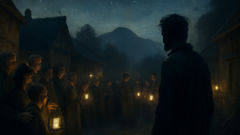
On the islands, fishermen’s tales speak the language of the sea. A beloved fisherman lost off the keel of his boat was found three days later on the beach, unmarked by decay and whispering of ocean voices. His wife burned his nets and smashed his oars, convinced that his return signaled a threat to the village’s children and animals. In the morning, a flock of bedraggled sheep lay scattered near the yard, drained of vigor. Islanders treated such returns as signs that the sea had not wholly given him back, that a part remained wedded to water and night. To guard against these, they used seawater in washing the hands of mourners and hung fish hooks in peculiar places as charm-laden talismans.
There are darker accounts. In a mountainous Epirus hamlet, a woman who had been ostracized in life — accused of witchery and buried without the blessing of the local priest — began to appear at windows, tapping with skeletal fingers. Her presence coincided with a rash of illnesses in the livestock, and young children developed rashes with no clear explanation. The villagers exhumed the grave and found the body in a state that they described as uncommonly whole for the time elapsed. The solution they chose — decapitation and burning — reads brutal today, but within their moral universe it was an act of communal self-preservation. They told the account for generations, not in triumph but with a tremor of guilt and a moral: to abandon the dead is to poison the living.
The aftermath of vrykolakas incidents often reveals as much about community dynamics as the haunting itself. Families that suffered such returns found themselves under scrutiny. Neighbors asked whether they had prayed adequately, whether the corpse had been handled properly, whether kin had been quick to reconcile old grievances. The vrykolakas functions as a mirror that magnifies social fault lines. When misfortune struck, people needed an explanation and a corrective. The rituals — exhumation, blessing, burning of possessions — served both as remedies and as public confessions of error: an admission that something had gone wrong and a commitment to restore order.
Yet not every vrykolakas story ends with violence. Some accounts emphasize reconciliation. A story from Crete records a case in which a family, terrified that their dead matriarch would return, opted for nightly vigils anchored in conversation rather than punitive acts. They recited life stories, sang old songs between bursts of prayer, and in the end the sense of threat diminished. The narrative suggests that attention, ritualized memory, and communal presence can be counterforces to the returning dead. This variant highlights the human impulse to tend to both the living and the memory of the dead without resorting to mutilation.
Across the twentieth century, as villages depopulated and modern medicine reduced the mystery around many forms of sudden death, the frequency of vrykolakas reports waned. Still, the legend never died. It moved into new forms: tourist narratives, folkloric collections, and scholarly articles that reframed the vrykolakas through lenses of anthropology and psychology. Modern retellings sometimes blend the classical horror elements with contemporary concerns — migration, isolation, ecological change — turning the revenant into a metaphor for loss that returns when a community’s bonds are stretched too thin.
Ultimately, the village stories of the vrykolakas endure because they answer a question everyone must learn to live with: How do we treat those who leave us too soon, and what do we owe the dead? Whether through the hard rituals of exhumation and binding or the gentler acts of memory and ceremony, communities wrote a script to manage the risk of return. The vrykolakas legend is a repository for those scripts, an oral archive where the anxieties of the living are negotiated and where cultural identity is, quite literally, sewn into the ground beneath the gravestones. While many of the old practices sit uneasily with modern sensibilities, they were, in their time, survival strategies for small societies facing the tangible dangers of contagion, confusion, and the raw social disruption of unprocessed grief. Listening to these stories today gives us more than chills; it offers a window into how entire communities structured meaning around death and how folklore can persist as both warning and instruction for generations to come.
Conclusion
The myth of the vrykolakas persists because it answers a primal communal question: what do we do when death fails to respect the rules we’ve built around life? In its many forms the vrykolakas asks us to look at how rituals, beliefs, and the architecture of care bind people together when grief arrives uninvited. These stories are not idle superstitions; they are cultural responses to the anxieties of sudden loss, to the dangers of mismanaged burial, and to the moral requirement that the living must act to preserve one another. Whether a community closed a grave with a stone, set rosemary upon a coffin, or sat awake and recited the names of those they had lost, these acts signaled a commitment to order in a world that too often promises confusion. Today, as the practical reasons for many old rites fade with improved medicine and the decline of close-knit rural life, the vrykolakas remains a potent emblem: a reminder that mourning is communal work and that stories—with all their terror and tenderness—help us rehearse the rituals that keep societies intact. In remembering these tales, we also inherit their lessons: to tend the dead with care, to attend to the living with compassion, and to recognize that sometimes the most monstrous thing is not a creature clawing at a door but the silence left by a ritual neglected. The vrykolakas will continue to haunt our imaginations as long as we need a story to hold our fears about death, community, and the fragile line that separates memory from menace.

